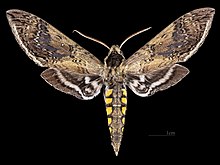| This article needs additional citations for verification. Please help improve this article by adding citations to reliable sources. Unsourced material may be challenged and removed. Find sources: "Manduca hannibal" – news · newspapers · books · scholar · JSTOR (December 2009) (Learn how and when to remove this message) |
| Manduca hannibal | |
|---|---|

| |
| Manduca hannibal Male dorsal | |

| |
| Manduca hannibal Male ventral | |
| Scientific classification | |
| Domain: | Eukaryota |
| Kingdom: | Animalia |
| Phylum: | Arthropoda |
| Class: | Insecta |
| Order: | Lepidoptera |
| Family: | Sphingidae |
| Genus: | Manduca |
| Species: | M. hannibal |
| Binomial name | |
| Manduca hannibal (Cramer, 1779) | |
| Synonyms | |
| |
Manduca hannibal is a moth of the family Sphingidae.
Distribution
It is found from Mexico, Belize, Nicaragua and Costa Rica to Suriname, Venezuela, Ecuador, Brazil, Bolivia and north-eastern Argentina.
Description
The wingspan is 99–114 mm. There is a whitish subbasal band on the hindwing upperside and a generally rather large dirty white patch within the black central band near the anal angle.
Biology
There are multiple generations per year in Costa Rica, with adults recorded year round except January and March. In Bolivia, adults have been recorded in February, April, August, October and December.
The larvae feed on Aegiphila martinicensis.
Subspecies
- Manduca hannibal hannibal (from Mexico, Belize, Nicaragua and Costa Rica to Surinam, Venezuela, Ecuador, Brazil and Bolivia)
- Manduca hannibal hamilcar (Boisduval, 1875) (Brazil and north-eastern Argentina)
- Manduca hannibal mayeri (Mooser, 1940) (Mexico)
References
- CATE Creating a Taxonomic eScience - Sphingidae Archived 2012-07-21 at archive.today
 This article incorporates text from this source, which is in the public domain.
This article incorporates text from this source, which is in the public domain.
- Silkmoths
| Taxon identifiers | |
|---|---|
| Manduca hannibal | |
This Manduca-related article is a stub. You can help Misplaced Pages by expanding it. |

